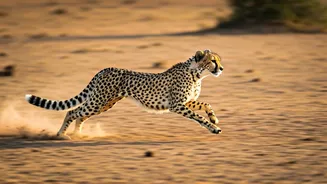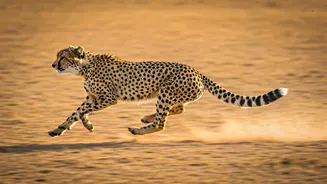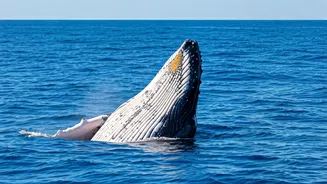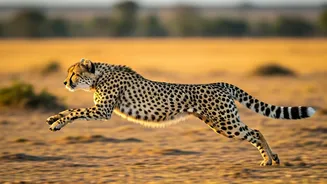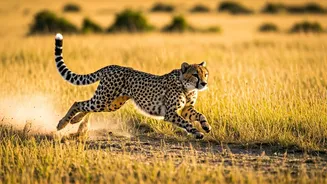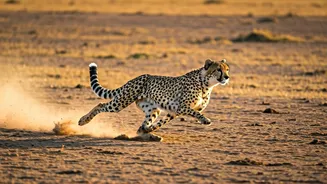Cheetah: Land's Fastest
The cheetah, an icon of speed, claims the crown as the fastest land animal. Known for its sleek body, flexible spine, and large nostrils, the cheetah can
accelerate from 0 to 60 mph (97 km/h) in a mere three seconds. This incredible burst of speed is essential for hunting prey across the vast savannas and grasslands of Africa. The cheetah's long legs and non-retractable claws provide superior traction, enabling it to maintain balance and power during high-speed chases. Their specialized cardiovascular system ensures they can efficiently deliver oxygen to their muscles, crucial for sustaining such rapid bursts of activity. When they pursue prey, like gazelles or impalas, they can reach speeds up to 75 mph (120 km/h) over short distances. Their survival depends on this ability to outrun potential meals.
Peregrine Falcon: Diving Ace
The Peregrine Falcon is a master of the skies, achieving the title of the fastest animal in the world during its hunting dives. When this bird of prey spots a target, it folds its wings and plummets towards the ground, reaching speeds that can exceed 200 mph (322 km/h). Its streamlined body and powerful muscles, along with specialized feathers that minimize drag, make this incredible velocity possible. These falcons reside on nearly every continent, and they are frequently seen in diverse habitats, including coastal areas, open fields, and even urban landscapes. They feed mostly on other birds, which they capture mid-air, relying on their speed and precision to secure their meals.
Sailfish: Ocean's Champion
Sailfish hold the record as one of the swiftest creatures in the ocean. These magnificent fish, found in warm waters worldwide, have been recorded reaching speeds up to 68 mph (110 km/h). Their name comes from their enormous dorsal fin, which resembles a sail. Sailfish are built for speed, with a streamlined body and a powerful, crescent-shaped tail. This is what allows them to move swiftly through the water. They are apex predators, hunting smaller fish and squid. They use their impressive speed to catch prey. The sailfish is a truly remarkable aquatic athlete.
Pronghorn: American Speedster
The Pronghorn, native to North America, is the continent's fastest land mammal. It can maintain speeds of up to 55 mph (88 km/h) over extended distances, and it can also sprint at higher speeds for short bursts. The pronghorn evolved with speed as its primary defense against predators. Their large lungs and heart, alongside a light bone structure, allow for exceptional endurance. They are well-adapted to the open grasslands and deserts where they live, with excellent eyesight that allows them to spot danger from afar. These animals often cover vast distances in search of food and water.
Black Marlin: Deep-Sea Dash
The Black Marlin, known for its size and power, is another speed champion of the ocean. These massive fish can attain speeds of up to 80 mph (129 km/h) when hunting or fleeing. They possess a spear-like bill and a streamlined body, which reduces drag and improves their agility in the water. Black marlin is found in tropical and subtropical waters. They are apex predators, feeding on other fish and marine animals. The combination of speed, strength, and size allows them to dominate their marine habitat, making them a marvel to watch.
Frigatebird: Aerial Acrobats
Frigatebirds are masters of the sky, known for their exceptional aerial agility. While not the fastest fliers in level flight, they have been recorded at high speeds during dives. These birds can fly continuously for days, and they are known for their exceptional maneuverability. They have a long, forked tail and large wingspans. This helps them navigate the air currents efficiently. They often steal food from other birds. These birds are a spectacular sight, demonstrating a mix of grace and speed in their unique lifestyle.
Greyhound: Racing Royalty
Greyhounds are renowned for their speed. Bred specifically for racing, they can reach speeds up to 45 mph (72 km/h). Greyhounds have a lean, muscular build, designed for speed and agility. Their long legs, deep chest, and flexible spine contribute to their remarkable velocity. Historically used for hunting, they are now popular in racing circuits around the world. These dogs are able to maintain a quick pace for relatively short distances, and they are capable of accelerating rapidly.
